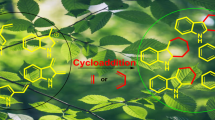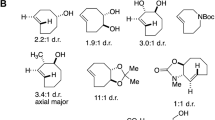Abstract
The development of new polymerization routes to afford N-heterocyclic polymers is of vital importance and highly desired for various practical applications. Herein, a facile and efficient polyannulation reaction of dual-activated alkyne and pyridines was developed to construct novel N-heterocyclic poly(quinolizine)s. This polymerization can proceed smoothly under catalyst-free conditions with 100% atom utilization to furnish poly(quinolizine)s with high molecular weights (up to 34,100) and well-defined structures in acceptable yields. The resulting polymers show good solubility, high thermal stability and strong red emission. Moreover, the prepared poly(quinolizine)s exhibit low cytotoxicity and can selectively label lysosomes in live cells. Considering the remarkable advantages of readily available raw materials, mild polymerization conditions, atom economy, and excellent product performance, this new and efficient polymerization tool will open up enormous opportunities for preparing functional N-heterocyclic polymers.

Similar content being viewed by others
References
Ahlheim M, Barzoukas M, Bedworth PV, Blanchard-Desce M, Fort A, Hu ZY, Marder SR, Perry JW, Runser C, Staehelin M, Zysset B. Science, 1996, 271: 335–337
Mahesh K, Karpagam S, Pandian K. Top Curr Chem (Z), 2019, 377: 12
Wang T, Zhang N, Bai W, Bao Y. Polym Chem, 2020, 11: 3095–3114
Dai C, Liu B. Energy Environ Sci, 2020, 13: 24–52
Mao T, Liu G, Wu H, Wei Y, Gou Y, Wang J, Tao L. J Am Chem Soc, 2018, 140: 6865–6872
Song B, Hu K, Qin A, Tang BZ. Macromolecules, 2018, 51: 7013–7018
Sheberla D, Patra S, Wijsboom YH, Sharma S, Sheynin Y, Haj-Yahia AE, Barak AH, Gidron O, Bendikov M. Chem Sci, 2015, 6: 360–371
Geervliet TA, Gavrila I, Iasilli G, Picchioni F, Pucci A. Chem Asian J, 2019, 14: 877–883
Osaka I, McCullough RD. Acc Chem Res, 2008, 41: 1202–1214
Linh NN, Duong TTT, Hien N, Trung VQ. Vietnam J Chem, 2020, 58: 1–9
Sohn H, Sailor MJ, Magde D, Trogler WC. J Am Chem Soc, 2003, 125: 3821–3830
Liu W, Luo X, Bao Y, Liu YP, Ning GH, Abdelwahab I, Li L, Nai CT, Hu ZG, Zhao D, Liu B, Quek SY, Loh KP. Nat Chem, 2017, 9: 563–570
Chen L, Ruan C, Yang R, Wang YZ. Polym Chem, 2014, 5: 3737–3749
Vu KB, Vu VV, Thi Thu HP, Giang HN, Tam NM, Ngo ST. Synth Met, 2018, 246: 128–136
Ciardelli F, Ruggeri G, Pucci A. Chem Soc Rev, 2013, 42: 857–870
Wang LX, Li XG, Yang YL. React Funct Polym, 2001, 47: 125–139
Liaw DJ, Wang KL, Huang YC, Lee KR, Lai JY, Ha CS. Prog Polym Sci, 2012, 37: 907–974
Li H, Sun J, Qin A, Tang BZ. Chin J Polym Sci, 2012, 30: 1–15
Qin A, Lam JWY, Jim CKW, Zhang L, Yan J, Häussler M, Liu J, Dong Y, Liang D, Chen E, Jia G, Tang BZ. Macromolecules, 2008, 41: 3808–3822
Truong VX, Ablett MP, Gilbert HTJ, Bowen J, Richardson SM, Hoyland JA, Dove AP. Biomater Sci, 2014, 2: 167–175
He B, Zhang J, Zhang H, Liu Z, Zou H, Hu R, Qin A, Kwok RTK, Lam JWY, Tang BZ. Macromolecules, 2020, 53: 3756–3764
Xu L, Zhou T, Liao M, Hu R, Tang BZ. ACS Macro Lett, 2019, 8: 101–106
Hu Y, Yan N, Liu X, Pei L, Ye C, Wang W-X, Lam JWY, Tang BZ. CCS Chem, 2021, 3: 2226–2238
Fu W, Dong L, Shi J, Tong B, Cai Z, Zhi J, Dong Y. Macromolecules, 2018, 51: 3254–3263
Liu Y, Gao M, Zhao Z, Lam JWY, Tang BZ. Polym Chem, 2016, 7: 5436–5444
Schwartz A, Pál Z, Szabó L, Simon K, Hermecz I, Mészáros Z. J Heterocyclic Chem, 1987, 24: 645–650
Govindachari TR, Thyagarajan BS. Proc Ind Acad Sci, 1954, 39: 232–239
Tominaga Y, Yokota K, Hagimori M, Shigemitsu Y, Mizuyama N, Wang BC. Heterocycles, 2009, 78: 1271–1279
Hagimori M, Matsui S, Mizuyama N, Yokota K, Nagaoka J, Tominaga Y. Eur J Org Chem, 2009, 2009(33): 5847–5853
Diels O, Alder K. Justus Liebigs Ann Chem, 1932, 498: 16–49
Liu Y, Qin A, Tang BZ. Prog Polym Sci, 2018, 78: 92–138
Das A, Theato P. Chem Rev, 2016, 116: 1434–1495
Truong VX, Ablett MP, Richardson SM, Hoyland JA, Dove AP. J Am Chem Soc, 2015, 137: 1618–1622
Bell CA, Yu J, Barker IA, Truong VX, Cao Z, Dobrinyin AV, Becker ML, Dove AP. Angew Chem Int Ed, 2016, 55: 13076–13080
Worch JC, Weems AC, Yu J, Arno MC, Wilks TR, Huckstepp RTR, O’Reilly RK, Becker ML, Dove AP. Nat Commun, 2020, 11: 3250
Daglar O, Gunay US, Hizal G, Tunca U, Durmaz H. Macromolecules, 2019, 52: 3558–3572
Daglar O, Cakmakci E, Gunay US, Hizal G, Tunca U, Durmaz H. Macromolecules, 2020, 53: 2965–2975
Daglar O, Çakmakçi E, Hizal G, Tunca U, Durmaz H. Eur Polym J, 2020, 130: 109681
He B, Huang J, Liu X, Zhang J, Lam JWY, Tang BZ. Prog Polym Sci, 2022, 126: 101503
He B, Su H, Bai T, Wu Y, Li S, Gao M, Hu R, Zhao Z, Qin A, Ling J, Tang BZ. J Am Chem Soc, 2017, 139: 5437–5443
He B, Zhen S, Wu Y, Hu R, Zhao Z, Qin A, Tang BZ. Polym Chem, 2016, 7: 7375–7382
He B, Zhang J, Wang J, Wu Y, Qin A, Tang BZ. Macromolecules, 2020, 53: 5248–5254
Wei B, Li W, Zhao Z, Qin A, Hu R, Tang BZ. J Am Chem Soc, 2017, 139: 5075–5084
Wu X, Li W, Hu R, Tang BZ. Macromol Rapid Commun, 2021, 42: 2000633
Gao H, Zhang N, Li Y, Zhao W, Quan Y, Cheng Y, Chen HY, Xu JJ. Sci China Chem, 2020, 63: 715–721
Zhang Z, Ma W, Xu B, Zhou X, Wang C, Xie Z, Liu L, Ma Y. Sci China Chem, 2018, 61: 192–199
He B, Huang J, Zhang J, Sung HHY, Lam JWY, Zhang Z, Yan S, Wang D, Zhang J, Tang BZ. Angew Chem Int Ed, 2022, 61: e202117709
Zhang J, He B, Hu Y, Alam P, Zhang H, Lam JWY, Tang BZ. Adv Mater, 2021, 33: 2008071
Wada K, Hashimoto K, Ochi J, Tanaka K, Chujo Y. Aggregate, 2021, 2: e93
Qi J, Ou H, Liu Q, Ding D. Aggregate, 2021, 2: 95–113
Acknowledgements
This work was supported by the National Natural Science Foundation of China (22101028, 21788102), the start-up funding from Beijing Normal University (310432102, 310432103), the Innovation and Technology Commission (ITC-CNERC14SC01), the Science and Technology Plan of Shenzhen (JCYJ20160229205601482, JCYJ20180507183832744, JCYJ20170818113602462), the Natural Science Foundation of Guangdong Province (2019B121205002), and the Research Grants Council of Hong Kong (16305618, 16304819, 16305320, N-HKUST609/19, C6009-17G, C6014-20W/16).
Author information
Authors and Affiliations
Corresponding authors
Ethics declarations
Conflict of interest The authors declare no conflict of interest.
Additional information
Supporting information The supporting information is available online at http://chem.scichina.com and http://link.springer.com/journal/11426. The supporting materials are published as submitted, without typesetting or editing. The responsibility for scientific accuracy and content remains entirely with the authors.
Rights and permissions
About this article
Cite this article
He, B., Huang, J., Zhang, J. et al. In-situ generation of poly(quinolizine)s via catalyst-free polyannulations of activated diyne and pyridines. Sci. China Chem. 65, 789–795 (2022). https://doi.org/10.1007/s11426-021-1225-4
Received:
Accepted:
Published:
Issue Date:
DOI: https://doi.org/10.1007/s11426-021-1225-4




